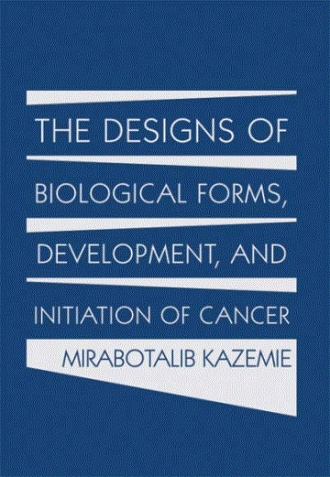The Designs of Biological Forms, Development, and Initiation of Cancer
by Mirabotalib Kazemie
Book Cover & Preview Text

Cancer cells share many characteristics of urprimordial cells, such as their potential for indefinite growth, the increased mobility of their cell membrane and membrane proteins, their diminished ability to adhere to a solid surface, and their growing even without attachment to cellular matrix. Nevertheless, I consider them as ‘defective urprimordial cells’. How normal metazoans’ cells turn into defective urprimordial cells, I describe in the following.
As we know, normal cells, both embryonic and differentiated, become cancerous when one or more of some important proteins, such as growth factors, growth factors’ receptors, protein kinases and nuclear proteins are altered. It is for this reason that the normal genes for those proteins are called proto-oncogenes. Normally, one expects that mutations in important cell proteins would lead to cessation of cell functions, but in case of these proteins it is the opposite, their mutations lead to intensification of cell growth. Why they do this? If there were a cancer-making system inside a normal metazoans’ cell, the answer to this question would sounded simply like this: those mutated proteins turn that cancer-making system on. However, it is not in the interest of an organism to have such a system of self-destruction. It is also very unlikely to assume that some altered cell proteins are capable of changing the whole chemistry of a cell to the extent to make it cancerous. One way of finding the connection between the proto-oncogens and the intiation of cancer, in my view, is to look into the reasons behind the phenomena of attachment of dividing cells to the extra-cellular matrix, the so-called social behaviour of the cells. I believe that before a cell belonging to a tissue or organ starts to divide, it seeks the approval of the neighbouring cells to ensure that it divides within the context of the general design of the organism, whether this organism is a human being, a monkey, a cat, a mouse, a chicken, etc. It does this using something which looks like an identification card. Once its identification card is being approved by neighbouring cells, that particular cell loosens its contacts again and starts dividing. In this ‘identification cards’ is the organism’s design encrypted. Its ‘words and letters’ consist, among others, of growth factors, growth factors’ receptors, protein kinases and nuclear proteins that are known as proto-oncogenes, the signalling proteins that are stretched from the surface of the cell to the nucleus. Since these proteins are invariant proteins, according to the primordialization theory, they must have part in the primordial programs that determine the designs of the organisms and so the proper place and function of their cells within their specific boundaries. In any cell of a metazoan when a protein that is involved in its primordial program is altered, that cell turns into a defective urprimordial cell. A defective urprimordial cell fails to recognize the primordial program of the neighbouring cells.
Distinction between the process that leads to the formation of Placenta and the process that leads to initiation of cancer
Book Details
About the Book
Looking at the uniqueness of each biological form, I assume that the designs of a biological form must be determined by a regulative system coded by certain groups of invariant proteins. The mechanism in charge of combining these proteins in specific patterns to produce design programs I call primordialization. A design program determines the design and the layout of the structures of the organism during its embryonic development. The patterns of proteins' combinations in primordial programs cannot be shifted one into another by environmental factors. If the amino acid sequence of any of the participating proteins is altered, the design program will obliterate. In case such an alteration happens inside an egg cell, one of the two possibilities is expected to occur. Either the affected cell is no longer viable and dies out, or develops into a creature with indistinct body design. Alteration of the proteins involved in a design program can occur also at any time during an organism’s development and later. In such situations the affected cells can turn into a cancer cell
About the Author
The author is a biologist and medical doctor (Ph. D. sc., Ph. D. med., M. D., M. Sc.). He obtained his degrees from the German universities and is expert in protein biochemistry



